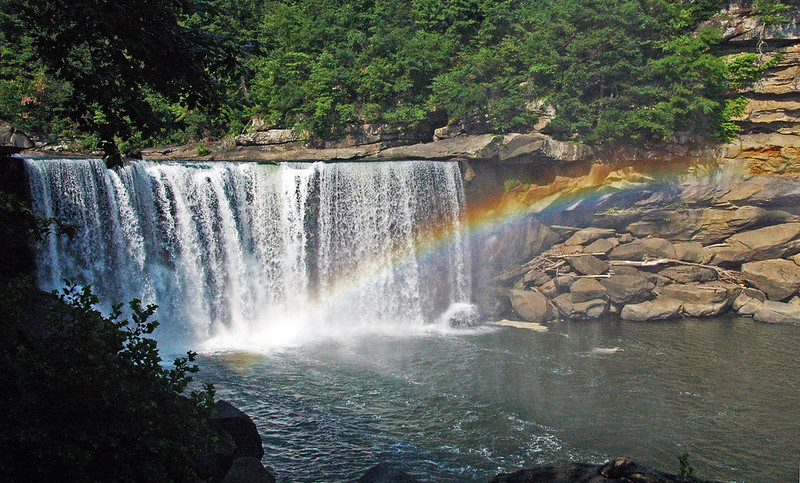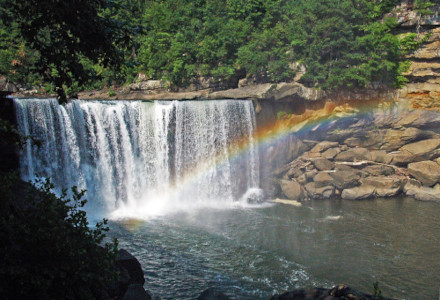
Cumberland Falls Facts
- This phenomenally beautiful product of time and natural forces most frequently goes by the name of Cumberland Falls. It does have several other, alternate names, though. Those include the terms of Great Falls, Little Niagara, and Niagara of the South.
- No matter which of these names one chooses to use when speaking of it, the formation remains a true natural wonder. It earns these names, as well as other accolades, due to its many charms. The stunning waterfall is a true marvel to visit and behold.
- It also stands out due to several claims to fame. Leading off these is the fact that it ranks as the second largest cascade east of the Rocky Mountains. But it doesn’t stop there. It holds the distinction of having the largest volume in its portion of the country.
- Ancient Native Americans knew of this natural beauty. Archaeological evidence indicates that they discovered it 10,000 years ago. Four known tribes of Indigenous Peoples knew of it. Those were the Cherokee, Shawnee, Chickasaw, and Creek.
- The first outsider to learn of the existence of Cumberland Falls was the local explorer, Thomas Walker. He made the fortunate discovery in 1750. At the time, he named the magnificent formation in honor of the Duke of Cumberland and Strathearn.
- Today, it’s a popular local tourist draw. It also serves as the central feature of the Cumberland Falls State Resort Park. It’s best known for one remarkable attribute. The spot’s the only site in the Western Hemisphere where a moonbow is routinely visible.
Related Articles
Cumberland Falls Physical Description
Gorgeous Cumberland Falls captivates those adventurous enough to seek it out. Unlike some similar features around the world, though, it does so for more than one simple reason. That’s true since this geological marvel impresses due to both size and beauty.
Clearly, it doesn’t compare in physical dimensions with other waterfalls around the world for sheer volume, such as Victoria Falls. Nevertheless, it does boast some quite respectable measurements. These are enough to make an impression on most visitors.
Those exact dimensions do vary, of course, due to local climatic conditions. Overall, however, the visually stunning cascade plunges an average of approximately 68 ft (21 m) to the river below. The water flows over an underlying bed composed mainly of sandstone.
While it certainly isn’t all that tall, Cumberland Falls nonetheless captures one’s attention due to its width. That’s because this natural beauty averages roughly 125 ft (38 m) wide across its expanse. That aspect also varies, depending on inflow rates, of course.
The waters flowing into this remarkable waterfall originate over an impressively large area. That gathers from a drainage area comprising a total of 1,977 sq mi (5,120 sq km). Rainfall and snowmelt serve as the principal sources for both cascade and the river it’s part of.
Cumberland Falls Location, Formation, and Distinctiveness
The magnificent Cumberland Falls formed in a greater region of the world already renowned for its abundance of geological marvels. That region, in fact, likely won’t surprise anyone. This creation of natural forces formed as part of what’s now the continent of North America.
There, it lies within the borders of the United States. It’s further situted inside the boundaries of the state of Kentucky, in the southeastern portion of the country. It draws its name from the Cumberland River, on which it sits, in the southeastern part of the state.
Evidence indicates that it once appeared in another location, in another part of the state. Changing conditions apparently caused its relocation to its current site, about 45 mi (72 km) upstream. In doing so, it carved out what’s now known as the Cumberland River Gorge.
Further research also indicates that its tansformation remains ongoing. It once stood both taller and held a greater flow. Due to the nature of the underlying sandstone, erosion of its base continues. Its expected that the cascade will eventually disappear completely.
Cumberland Falls stands out for one reason above all others. That’s due to the presence of what’s called a moonbow. This happens only either during or close to a full moon. At such times, the moonbow, also called a lunar rainbow, occasionally occurs for short periods.
This happens when sufficient light reflected by the moon exists, and passes through the mist from the falls. Its formation is also aided by the steep walls of the gorge it’s in. That reduces dissipation of the mist. It’s also enhanced by the width of the gorge, allowing for more light.
Features Sharing Its Region
Check out our other articles on 3 Enchanting Marvels of Ethiopia, Amazonian Manatee, Great Barrier Reef, Wheel Flower, Franklin’s Bumblebee, Philippine sailfin lizard

